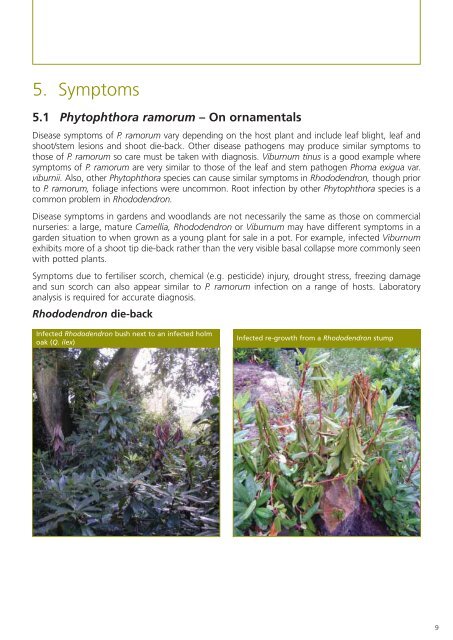Phytophthora ramorum - The Food and Environment Research ...
Phytophthora ramorum - The Food and Environment Research ...
Phytophthora ramorum - The Food and Environment Research ...
You also want an ePaper? Increase the reach of your titles
YUMPU automatically turns print PDFs into web optimized ePapers that Google loves.
5. Symptoms<br />
5.1 <strong>Phytophthora</strong> <strong>ramorum</strong> – On ornamentals<br />
Disease symptoms of P. <strong>ramorum</strong> vary depending on the host plant <strong>and</strong> include leaf blight, leaf <strong>and</strong><br />
shoot/stem lesions <strong>and</strong> shoot die-back. Other disease pathogens may produce similar symptoms to<br />
those of P. <strong>ramorum</strong> so care must be taken with diagnosis. Viburnum tinus is a good example where<br />
symptoms of P. <strong>ramorum</strong> are very similar to those of the leaf <strong>and</strong> stem pathogen Phoma exigua var.<br />
viburnii. Also, other <strong>Phytophthora</strong> species can cause similar symptoms in Rhododendron, though prior<br />
to P. <strong>ramorum</strong>, foliage infections were uncommon. Root infection by other <strong>Phytophthora</strong> species is a<br />
common problem in Rhododendron.<br />
Disease symptoms in gardens <strong>and</strong> woodl<strong>and</strong>s are not necessarily the same as those on commercial<br />
nurseries: a large, mature Camellia, Rhododendron or Viburnum may have different symptoms in a<br />
garden situation to when grown as a young plant for sale in a pot. For example, infected Viburnum<br />
exhibits more of a shoot tip die-back rather than the very visible basal collapse more commonly seen<br />
with potted plants.<br />
Symptoms due to fertiliser scorch, chemical (e.g. pesticide) injury, drought stress, freezing damage<br />
<strong>and</strong> sun scorch can also appear similar to P. <strong>ramorum</strong> infection on a range of hosts. Laboratory<br />
analysis is required for accurate diagnosis.<br />
Rhododendron die-back<br />
Infected Rhododendron bush next to an infected holm<br />
oak (Q. ilex)<br />
Infected re-growth from a Rhododendron stump<br />
9
















